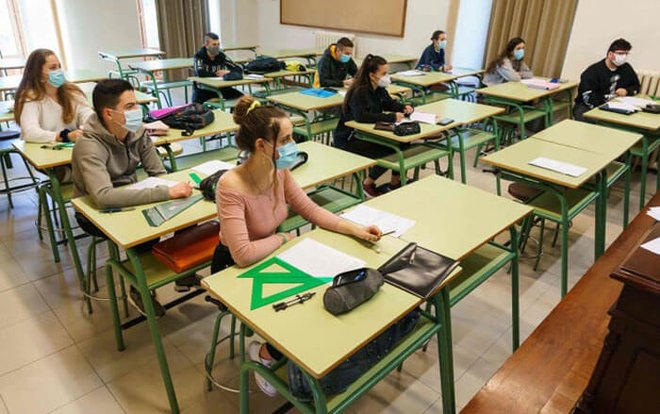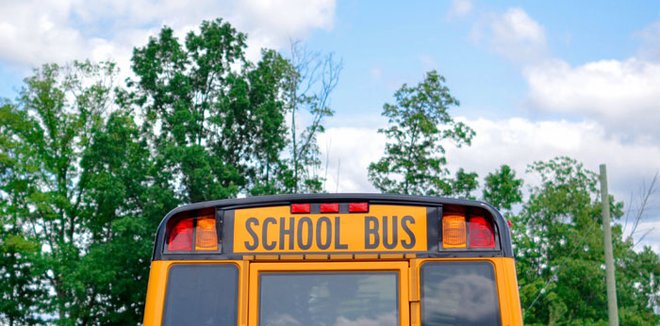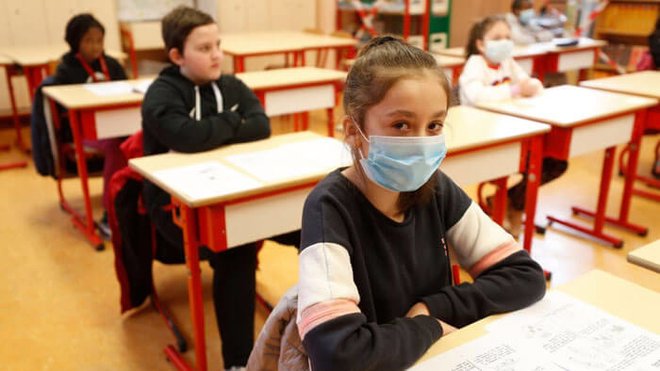Back To School 2020: Virtual or In-Person?
Pros and cons of virtual and in-person learning this school year
Aug 10, 2020Here we are—A new school year! As we prepare to go back (or maybe you already have), most of us will find that school looks quite different than we’re used to pre-COVID. You may have to wear a mask, wash your hands much more, have your temperature checked daily, socially-distance from your friends and teachers, and your classrooms will probably be half-full. School for you may be completely virtual, or you may be going into school for just part of the week, or part of the day. Choosing whether to have school virtually or in-person can be confusing for families. If you do happen to have a choice in the matter, there are so many factors to consider—some big and some small. Check out Kidzworld’s pros and cons list to help navigate the best decision for you and your family.
 Schools around the world have already made adjustments to in-person learning.Courtesy of jsonline.com.
Schools around the world have already made adjustments to in-person learning.Courtesy of jsonline.com.
In-Person/Hybrid Learning: Pros
- Face-to-face contact with teachers and classmates. This is probably the most important benefit of in-school learning. Interaction with your teachers makes learning and communication so much easier. The importance of in-person learning is well documented, according to the American Academy of Pediatrics. Just keep in mind that you may have unexpected teacher changes as schools grapple with possible teacher shortages and keeping staff safe.

- Social interaction. This is another biggie—You get to see your friends, or at least some of them. Leaving your house and seeing classmates every day in your school, in a real classroom, may mean the world to you—Even if you wear a mask and social distance. Just keep in mind, with current safety measures in place, that socialization opportunities will be greatly reduced at school right now.
- Kids who depend on school for healthy meals, therapy and stability will more easily get these services.
- You won’t have to change your clothes for gym. Okay, this is an admittedly small perk, but those who hate changing their clothes at gym-class time will appreciate it. Schools will want to limit locker use as much as possible for safety reasons.
- There’ll be less cafeteria, recess and school bus drama. If you hate drama, this may be an unexpected bonus. At lunch time, whether you’re eating in the cafeteria or in a classroom, you’ll sit spaced apart from other kids. Same with recess and the bus-ride. This means less of an opportunity for gossipers to start the next big scandal.

- Some of your classes may be outside. Recess, gym and other classes will likely be outside whenever possible because the virus is less transmittable outside, in open air.
- You might not have to ride the bus. Schools are encouraging parents to drive kids to and from school whenever possible.
 If you have to wear a mask, you'll likely have "mask breaks" througout the day.Courtesy of Irish Times.
If you have to wear a mask, you'll likely have "mask breaks" througout the day.Courtesy of Irish Times.
In-Person/Hybrid Learning: Cons
- It’s not as safe. Schools will do everything they can to make school as safe as possible for you, your teachers and the staff. Yet, with no vaccine and no capacity for widespread on-the-spot testing yet, there is no guarantee of 100% safety. Some schools might not have the budgets to fully implement cleaning, ventilation and social distancing guidelines, and it’s difficult to know at this point how well the guidelines will be enforced. Level of safety also depends on how high the infection rate is in your area. Many experts argue that a local daily infection rate of less than 5 percent, with a downward trend of at least 14 days, is a good way to know whether a community has the virus under control. The safety issue also extends to your family at home. Students can pass the virus to a family member at home, possibly without knowing it if they are asymptomatic.
- You may not have extracurricular activities. If you do, they’ll look much different. Singing groups and contact sports teams, where students expel a lot of air or are in close contact, are particularly higher risk.

- Distancing will make it hard to socialize. At lunch, recess, in the hall, and in class, you’ll have to be spaced apart from your classmates. You probably won’t see all your friends in class if your school adopts a staggered schedule, or you may be placed with the same small group of kids for all or most of your classes.
- You may be physically uncomfortable. Wearing a mask for most of the day will be an adjustment. If your school has an older ventilation system, there may be no air conditioning, and doors and windows may be open during winter months to improve ventilation.
- You still might be staring at a screen all day. There probably won’t be a lot of group assignments, paper assignments or hands-on science experiments for the time-being because it will be hard to do them safely. This leaves the iPad or laptop as a convenient choice to do work on while in school.
- You might be sitting in the same room for much of the day. Teachers may come to you, instead of the other way around.
- You may end up having to learn from home anyway. Depending on the changing conditions in your community, if the infection rate goes up, schools may close.
 Some families may choose to have their kids learn from home full-time this year.Courtesy of unsplash.com.
Some families may choose to have their kids learn from home full-time this year.Courtesy of unsplash.com.
Virtual Learning: Pros
- It’s safer. This is the biggie here. If you want a 100% safety guarantee, this is your best option right now.
- Virtual school will be more organized now. In the spring, schools scrambled to throw together an at-home learning system on the fly. Now that districts have had time to plan, kids who opt for virtual school should hopefully have a more structured and organized experience.
- You can get more sleep. Teenagers are biologically wired to stay up later and sleep later. With this option, you don’t have to schedule extra time to travel to and from school, which means your alarm clock can go off later!

- You have more flexibility about when to do your work. If you’re feeling under the weather one day, you may be able to take time to feel better and get your schoolwork completed later in the day.
- You can have school in your pajamas. You just might want to make sure that your camera is off during Zoom meetings!
- You might have more time to do other things. Most students attend a physical classroom for about 6 hours per day in the traditional K-12 public school system in the United States. Add in up to an hour of riding the bus each way for rural students and another 1-2 hours of homework per night for older students and the entire day is consumed by school. This depends largely on whatever virtual structure your school chooses to use, but you might get all the work done in less time at home.
- You may be able to learn with a few other kids. Working parents across the country whose kids are learning from home are teaming up with other families, setting up "pods," or small learning groups of same-age kids, that they supervise and help with school work on a rotating basis.
 Learning virtually offers more flexibility with your schedule, but also more opportunity to procrastinate.Courtesy of newrow.com.
Learning virtually offers more flexibility with your schedule, but also more opportunity to procrastinate.Courtesy of newrow.com.
Virtual Learning: Cons
- Spotty technology. About 17 percent of students nationwide lack a computer at home, according to a 2019 analysis by the Associated Press. Also, WiFi in some regions can be an issue, and some teachers may be less comfortable with technology, which may make it more challenging for them to effectively teach classes.
- You’ll have less in-person contact with friends and classmates. Socializing will have to be set up outside of school hours.
- You’ll have less contact with teachers. You’ll be missing out on hands-on instruction and may have less opportunities for communication with your teachers. If you don’t understand something, it may be harder to get clarification.
- You may not get the non-academic support you need, or it might be harder to do so. For instance, 20 million American kids rely on school lunches. It’s logistically harder to get these lunches to kids without having them in school.

- You may have distractions at home/Your parents may be unable to help you. This can be especially challenging if you have young siblings at home, or your parents must work outside the home all day. Also, things can get stressful if everyone is spending time together in one space all day, every day.
- It can be harder for some to stay focused on a computer screen all day. You may be more tempted to lose focus and procrastinate on school work.
- Electives are more difficult to take virtually. You may not be able to take all the classes you want due to staff shortages or for logistical reasons. Or, classes may not be as enjoyable. For instance, band and chorus classes taken from home will look, and feel, much different.
 Some schools may offer a hybrid schedule, where students go into school for part of the week and learn from home the remaining time.
Some schools may offer a hybrid schedule, where students go into school for part of the week and learn from home the remaining time.
Even though we know that our schools are doing everything they can to make them as safe and positive for you as possible, these changes can still feel like a drag. It’s okay to feel that way, and it will take time to adjust. None of these scenarios are ideal. Every student is different, and all families should do what works best for their particular situations. Regardless, it’s important to respect others’ opinions and wishes through all of this, and to remember that you’re not going through this alone. We’re all in this together as families, schools, communities, and as a country.
Share With Kidzworld
Are you going back to school this fall? Would you chose virtual or in-person schooling? Share below!

































